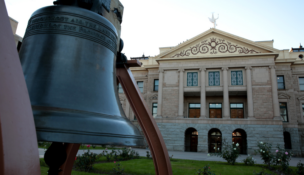Red ink rising to $1 billion
Arizona Capitol Reports Staff//December 7, 2007//[read_meter]
Barely a week after the Legislature’s budgeting agency said the state is facing an $800 million deficit for the current fiscal year, the Joint Legislative Budget Committee is set to announce Dec. 10 that it now predicts the shortfall will reach almost $1 billion.
Republican legislative leaders were briefed on the revised prediction the first week of December.
“Conditions are not improving. The gap is widening,” Senate Appropriations Chairman Bob Burns, R-9, said. “That’s a result of…economic activity declining.”
The revised projections are based on a four-sector consensus model, which averages four different economic outlooks. At the Dec. 10 meeting of the Finance Advisory Committee, JLBC is expected to adjust its shortfall prediction to $970 million for the current fiscal year and $1.8 billion for fiscal 2009, which starts next July 1.
Republican lawmakers say the only way to truly address the problem is to cut spending. Senate Majority Leader Thayer Verschoor, R-22, says lawmakers need to look at every available program.
“I’m not going to run around saying, ‘The sky is falling,’ but for the next couple years, we’re going to have to tighten our belt and practice some fiscal restraint,” he said.
House Appropriations Chairman Russell Pearce, R-18, says he and other lawmakers are “sweating hard on how to get there,” but is confident the Legislature can make the appropriate cuts, despite the increasing deficit.
Pearce, adamant that the state not borrow to solve the problem, says the first programs on the chopping block should be those that were recently created, in much the same way a business cutting costs will lay off its newest employees first. He also opposes using any of the more than $700 million in the state’s rainy day fund to address the shortfall, as the economic slump is expected to last until at least 2010.
“That’s not intended to fix budgets. That’s for emergencies, one-time problems,” he said.
One opponent to Pearce’s plan will undoubtedly be Gov. Janet Napolitano, who in September announced a plan to address what was then estimated to be a $600 million deficit. Her plan called for $100 million in as-yet-unidentified spending reductions, $200 million from the rainy day fund and $300 million in borrowing to pay for new school construction.
She has not yet produced a revised plan reflecting the increased deficit estimate and has told reporters she does not intend to release details of her proposed spending cuts until the Legislature convenes in January.
Burns says legislative leaders are still formulating a plan of attack on how to best alter the existing budget to compensate for the declining revenues. The continually worsening forecasts, he says, do not make the task any easier for lawmakers.
“Every time you add a little more to this, it just becomes a little more difficult…because you just start running out of options,” he said.
While it is possible the problem will be solved by budget cuts alone, Burns concedes it is unlikely such a plan would be able to garner the support needed in both the Legislature and with Napolitano.
He said the likely plan of attack will be to develop a proposal that can win legislative approval and then hammer out a compromise with Napolitano.
Even Pearce, who has a reputation for being a fiscal hawk, knows a plan that includes only spending cuts won’t win any support with the governor.
“The reality is there’ll be some compromise [with Napolitano],” he said.
One idea that may gain traction at the Capitol in the face of such large deficits is a push to repeal a Constitutional provision that prevents lawmakers from repealing any measure approved by voters. In recent years, voters have mandated the state pay for health care and education, which has in turn hand-cuffed the Legislature’s ability to budget. In total, voter-mandated funding for programs accounts for more than half of the budget the Legislature approves each year.
“I think we need to maybe put something back on the ballot to sunset some of the funding mandates,” Rep. Jonathan Paton, R-30, said. “That’s one of the major problems that’s tying our hands.”
Last year, a measure was introduced that would have amended the Constitution to permit the Legislature to repeal or change a voter-approved act four years after it was on the ballot. Rep. Kirk Adams, R-19, sponsored last year’s measure and has previously indicated he will introduce similar legislation this year.
But such a solution would not ease the pain for lawmakers in the upcoming session. Burns says that, whatever lawmakers opt to do, the solutions will not be easy.
“The 19- and 20-percent revenue [growth] had kind of put people in the ‘there’s-no-end-to-the-good-we-can-do-in-sight’ mode of thinking,” he said. “Here we are, suffering the consequences of our overindulgence.”
















